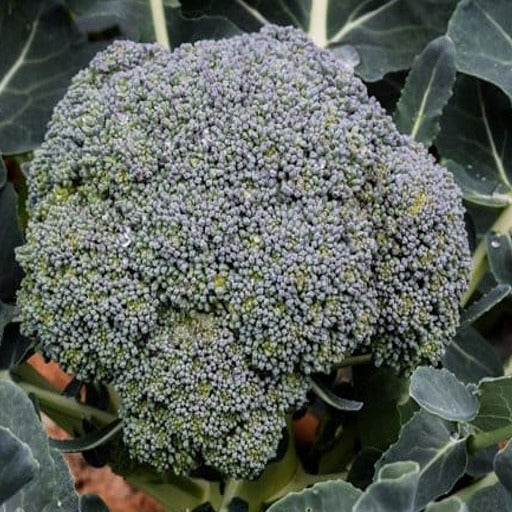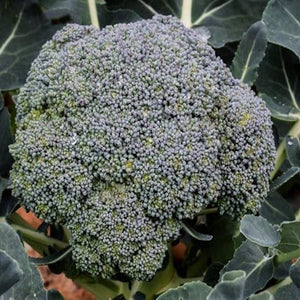- Hardiness Zone: 2-11 Annual
- Grow As Microgreens: Waltham 29 Broccoli Microgreens
Seed Depth: 1/4–1/2 inch
Seed Spacing: 18–24 inches
Row Spacing: 24–36 inches
Sunlight: Full sun to partial shade
Days to Sprout: 7–14 days
Days to Maturity: 85–100 days
Growth Habit: Upright
Sunlight: Choose a location that receives full sun for at least 6-8 hours a day.
Soil: Prefers well-drained, fertile soil with a pH between 6.0 and 7.5. Amend the soil with compost or well-rotted manure to enhance fertility and drainage.
When to Plant: Broccoli is a cool-season crop that can be planted in early spring or late summer for a fall harvest. Start seeds indoors 6-8 weeks before the last expected frost date for a spring crop, or sow seeds directly in the garden in late summer for a fall crop.
Starting Indoors: Sow seeds 1/4 inch deep in seed-starting mix. Keep the soil moist and maintain a temperature of 60-70°F (15-21°C). Transplant seedlings outdoors when they have 4-6 true leaves and the danger of frost has passed.
Direct Sowing: Sow seeds directly in the garden 1/2 inch deep and 3 inches apart in rows spaced 18-24 inches apart. Thin seedlings to stand 12-18 inches apart once they are a few inches tall.
Succession Planting: Sow seeds every 2–3 weeks for a continuous harvest.
Watering: Keep the soil consistently moist but not waterlogged. Water broccoli regularly, especially during dry periods. Mulch around the plants to retain soil moisture and suppress weeds.
Fertilization: Broccoli is a heavy feeder. Apply a balanced fertilizer or compost at planting time and again when the plants are 3-4 weeks old. Side-dress with compost or a balanced fertilizer when heads begin to form.
Mulching and Weeding: Apply a layer of mulch around the plants to retain soil moisture, suppress weeds, and keep the soil temperature consistent. Hand-pull weeds carefully to avoid disturbing the shallow roots of the broccoli.
Pruning: Remove yellowing or damaged leaves to maintain airflow and reduce disease risk.
Pest and Disease Management: Watch for common pests such as aphids, cabbage worms, and flea beetles. Use organic pest control methods like neem oil, insecticidal soap, or hand-picking to manage infestations. Practice crop rotation and ensure good air circulation to prevent fungal diseases like downy mildew and clubroot.
When to Harvest: The main head is typically ready to harvest 85-100 days after planting. Harvest when the head is firm and tight, before the individual florets begin to open.
How to Harvest: Use a sharp knife to cut the main head, leaving about 6 inches of the stem. After harvesting the main head, the plant will produce multiple side shoots, which can be harvested regularly.
Storing Fresh Broccoli: Freshly harvested broccoli can be stored in the refrigerator for up to a week. Place the heads in a plastic bag or container to retain moisture.
Culinary Uses: Broccoli can be steamed, boiled, roasted, or sautéed. It's a versatile vegetable that can be used in stir-fries, soups, salads, casseroles, and as a nutritious side dish.
Why You’ll Love It
Waltham 29 Broccoli is a reliable, cold-tolerant heirloom developed for consistent performance in home gardens. It produces compact, uniform heads with densely packed florets and excellent flavor. After the main head is harvested, plants continue to produce flavorful side shoots, giving you multiple harvests from one planting. A great choice for fall crops or spring planting in cooler climates.
Plant Characteristics
Height: 18–24 inches
Growth Habit: Upright with central head and branching side shoots
Head Type: Tight, domed, dark green heads, 4–6 inches
Days to Maturity: 70–85 days
Hardiness: Cool-season biennial grown as an annual
Flavor and Culinary Uses
Flavor: Mild, nutty, and slightly sweet with tender texture
Culinary Uses: Perfect for steaming, roasting, stir-fries, casseroles, or raw snacking. Use florets and stems fresh or freeze for later use.
Companion Planting Tips
Good Companions: Onions, beets, celery, potatoes, and herbs like dill
Avoid Planting Near: Strawberries or other brassicas (cabbage, cauliflower) that share similar pests
Bonus Benefit: After cutting the main head, plants continue to produce nutritious side shoots for weeks
Common Issues and Solutions
Bolting in Heat: Plant early in spring or in late summer for fall harvests to avoid high temperatures
Aphids or Cabbage Worms: Use row covers and encourage beneficial insects to keep pests in check
Poor Head Development: Ensure plants receive full sun and adequate spacing to promote strong, uniform growth
Seeds Per Packet
| 500mg | Approximately 160 |
| 1g | Approximately 320 |
| 3g | Approximately 960 |
| 5g | Approximately 1,600 |
Why You’ll Love It
Waltham 29 Broccoli is a reliable, cold-tolerant heirloom developed for consistent performance in home gardens. It produces compact, uniform heads with densely packed florets and excellent flavor. After the main head is harvested, plants continue to produce flavorful side shoots, giving you multiple harvests from one planting. A great choice for fall crops or spring planting in cooler climates.
Plant Characteristics
Height: 18–24 inches
Growth Habit: Upright with central head and branching side shoots
Head Type: Tight, domed, dark green heads, 4–6 inches
Days to Maturity: 70–85 days
Hardiness: Cool-season biennial grown as an annual
Flavor and Culinary Uses
Flavor: Mild, nutty, and slightly sweet with tender texture
Culinary Uses: Perfect for steaming, roasting, stir-fries, casseroles, or raw snacking. Use florets and stems fresh or freeze for later use.
Companion Planting Tips
Good Companions: Onions, beets, celery, potatoes, and herbs like dill
Avoid Planting Near: Strawberries or other brassicas (cabbage, cauliflower) that share similar pests
Bonus Benefit: After cutting the main head, plants continue to produce nutritious side shoots for weeks
Common Issues and Solutions
Bolting in Heat: Plant early in spring or in late summer for fall harvests to avoid high temperatures
Aphids or Cabbage Worms: Use row covers and encourage beneficial insects to keep pests in check
Poor Head Development: Ensure plants receive full sun and adequate spacing to promote strong, uniform growth
Seeds Per Packet
| 500mg | Approximately 160 |
| 1g | Approximately 320 |
| 3g | Approximately 960 |
| 5g | Approximately 1,600 |






Share and get 15% off!
Simply share this product on one of the following social networks and you will unlock 15% off!